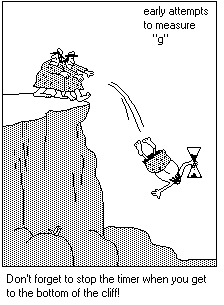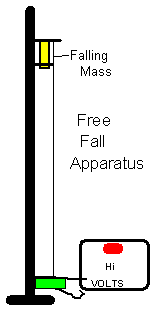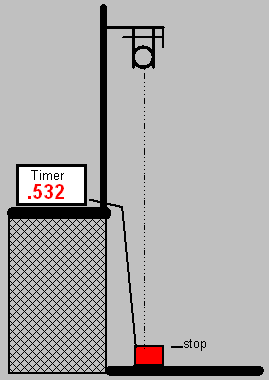GRAVITATIONAL ACCELERATION AT TAS

NAME ____________________________ PARTNER ________________________ DATE _______
PURPOSE
To measure the acceleration of gravity at TAS with the use of a Traditional Taiwanese Toy (Jien-Tze) and a variety of other materials and measurement apparatus.
MATERIALS
Assorted Jien-Tze, Pendulum bob, thread, air track with accessories, free fall apparatus, other materials chosen by students.
METHOD 1a - 'g' from a Jien-Tze a Traditional Taiwanese Toy dropped from the balcony
Drop a Jien-Tze from the balcony measure t, s; use g = 2s/t2 to find g.
Jien-Tze Dropped From The Balcony | ||||
Distance ___ |
Time ___ | g | ||
m |
s |
|||
m |
s |
|||
m |
s |
|||
METHOD 1b - 'g' from a rock dropped from the balcony
Drop a ball or rock from the balcony measure t, s; use g = 2s/t2 to find g.
Ball or Rock Dropped From The Balcony | ||
Distance ___ |
Time ___ | g |
m |
s |
|
m |
s |
|
METHOD 2 - 'g' from a Pendulum
You can easily measure the acceleration due to gravity using a pendulum. The period of a swing depends on g. The time T it takes for a round-trip swing is,
 In this formula
L is the length of the pendulum to the center of the swinging mass. If you
measure L with a ruler and T with a clock, you should be able to
solve for g. You may learn in a later physics course how to derive the formula.
Scientists often use formulas they have not derived themselves, as long
as they are confident of their validity.
In this formula
L is the length of the pendulum to the center of the swinging mass. If you
measure L with a ruler and T with a clock, you should be able to
solve for g. You may learn in a later physics course how to derive the formula.
Scientists often use formulas they have not derived themselves, as long
as they are confident of their validity.
Trial |
Length___ |
# Vibrations___ |
Time |
Period |
1 |
s | |||
2 |
s |
The formula is derived for a pendulum with all the mass concentrated in the weight at the bottom, called the bob. Hence the best pendulum to use is one whose bob is a metal sphere hung by a fine thread. In this case you can be sure that almost all the mass is in the bob. Your suspension thread can be any convenient length. Set up the pendulum and measure the pendulum's length, L, the distance from the point of suspension to the CENTER of the bob. Set the pendulum swinging with small swings. The formula doesn't work well for large swings, as you can test for yourself later. Time at least 20 complete round trips. By timing many round trips instead of just one you make the error in starting and stopping the clock a smaller fraction of the total time being measured. (When you divide by 20 to get the time for a single round trip, the error in the calculated value for one will be only 1/20 as large as if you had measured only one.) Divide the total time by the number of swings to find the period T of one swing. Repeat the measurement at least once with a different length. Finally, solve the formula for g, then substitute your measured quantities into the formula.
METHOD 3 - 'g' from a car on incline
Find the acceleration of a glider on an inclined air track. Measure t, the time to travel a distance, s. Then calculate the acceleration, a, by using the equations a = 2s/t2. Note that a is the component of vector g parallel to the plane so that a = g sin q . Solve the equations for g and calculate g from your data. It is almost impossible to release the glider with your fingers without giving it a slight push or pull. Therefore, hold it with a ruler or pencil and release it by quickly moving the pencil away from it down the inclined plane. The most difficult measurement to make accurately in this part is the angle; think of a way to do it that is better than using a protractor. It is important that you release the car so that it trips the first timer at the instant it begins to move; do you know why? Draw a diagram and describe how your method is most accurate
Car on A Hill | ||||||
Distance___ |
Time___ |
Accel |
Angle___ |
g | ||
m |
s |
ms2 |
||||
m |
s |
ms2 |
||||
METHOD 4 - 'g' from the Free Fall Apparatus

Determine g from the dots. Use every dot and be careful to include the effects of any missing dots. You can find "v" for each pair of dots using the definition:
![]()
Record the data on the tape. Fasten the tape to your report. Use Excel to plot a graph of v as a function of t; put in a trendline with its equation, use the slope to find g. Note that you cannot use g = 2s / t2 because the speed at the first dot is not zero.

METHOD 5 - 'g' from the Pasco digital free-fall apparatus
TRIAL |
Distance (m) ___ |
Time (s) ___ |
g (ms-2) |
1 |
|||
2 |
|||
3 |
|||
4 |
Place the metal ball in the digital falling ball apparatus and tighten the small screw so it stays in place. Set the stop switch on the floor directly under the ball. Measure the distance from the bottom of the ball to the stop switch. Loosen the screw so the ball falls. Record the fall time. Repeat the procedure several times for different distances; record all data. Use the average to estimate "g".
METHOD 6 - 'g' your way
Do a little research. Come up with your own method of determining g. (Use the computer; try the photogate timers, use a stroboscope and take a picture, use a video camera, use motion detectors, use a digital camera.)
ANALYSIS / CONCLUSIONS
Compare the methods for accuracy and precision. To do this you will need to compare results with several other students. Determine which method is consistently accurate. Explain why this method is both accurate and precise.
